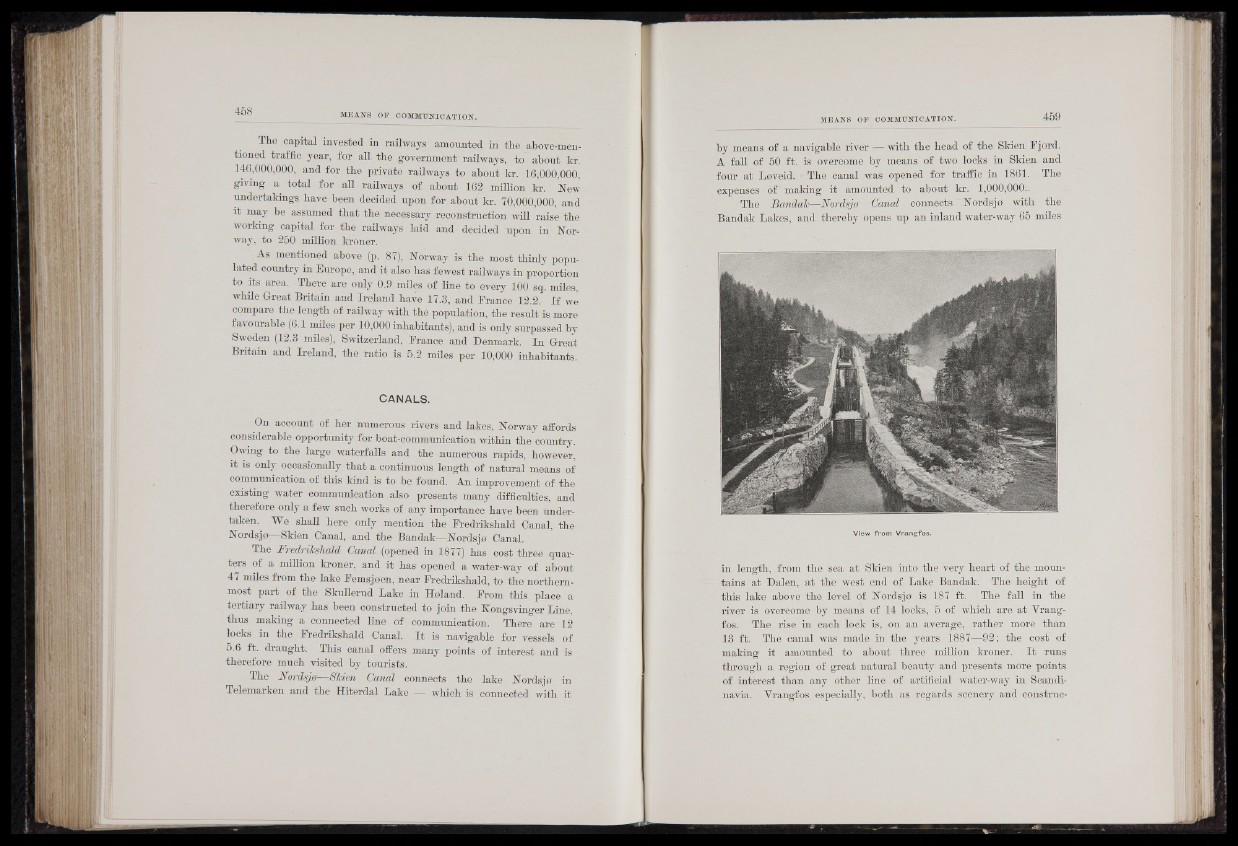
The capital invested in railways amounted in the above-mentioned
traffic year, for all the government railways, to about kr.
146,000,000, and for the private railways to about kr. 16,000,000,
giving a total for all railways -of about 162 million kr. New
undertakings have been decided upon for about kr. 70,000,000, and
it may be assumed that the necessary reconstruction will raise the
working capital for the railways laid and decided upon in Norway,
to 250 million kroner.
As mentioned above (p. 87), Norway is the most thinly populated
country in Europe, and it also has fewest railways in proportion
to its area. There are only 6.9 miles of line to every 100 sq. miles,
while Great Britain and Ireland have 17.3, and France 12.2. If we
compare the length of railway with the population, the result is more
favourable (6.1 miles per 10,000 inhabitants), and is only surpassed by
Sweden (12.3 miles), Switzerland, France and Denmark. In Great
Britain and Ireland, the ratio is 5.2 miles per 10,000 inhabitants.
CANALS.
On account of her numerous rivers and lakes, Norway affords
considerable opportunity for boat-communication within the country.
Owing to the large waterfalls and the numerous rapids, however,
it is only occasionally that a continuous length of natural means of
communication of this kind is to be found. An improvement of the
existing water communication also presents many difficulties, and
therefore only a few such works of any importance have been undertaken.
We shall here only mention the Fredrikshald Canal, the
Nordsj0—Skien Canal, and the Bandak—Nordsjo Canal.
The Fredrikshald Canal (opened in 1877) has cost three quarters
of a million kroner, and it has opened a water-way of about
47 miles from the lake Femsjoen, near Fredrikshald, to the northernmost
part of the Skullerud Lake in Holand. From this place a
tertiary railway has been constructed to join the Kongsvingor Line,
thus making a connected line of communication. There are 12
locks in the Fredrikshald Canal. I t is navigable for vessels of
5.6 ft. draught. This canal offers many points of interest and is
therefore much visited by tourists.
The Nordsj0—Shim Canal connects the lake Nordsj 0 in
Telemarken and the Hiterdal Lake — which is connected with it
by means of a navigable river S with the head of the Skien Fjord.
A fall of 50 ft. is overcome by means of two locks in Skien and
four at Loveid. The canal was opened for traffic in 1861. The
expenses of making it amounted to about kr. 1,000,000..
The Bandak—Nordsj0 Canal connects " Nordsjo with the
Bandak Lakes, and thereby opens up an inland water-way 65 miles
View from Vrangfos.
in length, from the sea at Skien into the very heart of thè mountains
at Dalen, at the west end of Lake Bandak. The height of
this lake above the level of Nordsj0 is 187 ft. The fall in the
river is overcome by means of 14 locks, 5 of which are at Vrangfos.
The rise in each lock is, on an average, rather more than
13 ft. The canal was made in the years 1887—92 ; the cost of
making it amounted to about three million kroner. I t runs
through a region of great natural beauty and presents more points
of interest than any other line of artificial water-way in Scandinavia.
Vrangfos, especially, both as regards scenery and construe